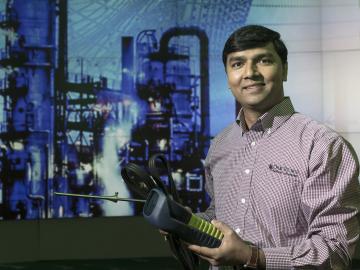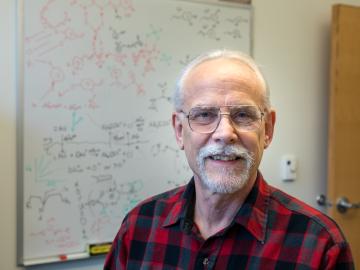
Filter News
Area of Research
News Type
News Topics
- 3-D Printing/Advanced Manufacturing (5)
- Advanced Reactors (1)
- Artificial Intelligence (4)
- Big Data (2)
- Bioenergy (4)
- Biomedical (2)
- Biotechnology (1)
- Clean Water (2)
- Computer Science (12)
- Energy Storage (3)
- Environment (9)
- Exascale Computing (1)
- Grid (1)
- Machine Learning (1)
- Materials Science (4)
- Mercury (1)
- Microscopy (1)
- Nanotechnology (2)
- Neutron Science (4)
- Nuclear Energy (7)
- Physics (2)
- Polymers (1)
- Quantum Science (2)
- Space Exploration (1)
- Summit (4)
- Sustainable Energy (1)
- Transportation (3)
Media Contacts

Scientists have demonstrated a new bio-inspired material for an eco-friendly and cost-effective approach to recovering uranium from seawater.

Researchers at the Department of Energy’s Oak Ridge National Laboratory, Pacific Northwest National Laboratory and Washington State University teamed up to investigate the complex dynamics of low-water liquids that challenge nuclear waste processing at federal cleanup sites.

Sachin Nimbalkar may have grown up in a small town in the shadows of India’s Sahyadri Mountains dreaming of outer space, but it’s the science of conserving energy in inner space where the engineer has made his mark.

When Scott Smith looks at a machine tool, he thinks not about what the powerful equipment used to shape metal can do – he’s imagining what it could do with the right added parts and strategies. As ORNL’s leader for a newly formed group, Machining and Machine Tool Research, Smith will have the opportunity to do just that.

Ionic conduction involves the movement of ions from one location to another inside a material. The ions travel through point defects, which are irregularities in the otherwise consistent arrangement of atoms known as the crystal lattice. This sometimes sluggish process can limit the performance and efficiency of fuel cells, batteries, and other energy storage technologies.

First, she wanted to be a postal worker just like her grandfather. Then, she wanted to be a teacher just like her mother. But ultimately, Candice Halbert chose a path all her own and now she is inspiring the next generation to be scientists—just like her.

Bruce Moyer’s career as a trailblazing chemist began with a Gilbert chemistry set, the perfect Christmas gift for an inquisitive kid growing up in 1960s Pennsylvania. Moyer squirreled away the test tubes and racks of chemicals in his bedroom to conduct unsupervised experiments on solubility, corrosion, and other subjects included in Gilbert’s captivating manual.

Scientists at the Department of Energy’s Oak Ridge National Laboratory are working to understand both the complex nature of uranium and the various oxide forms it can take during processing steps that might occur throughout the nuclear fuel cycle.

Using artificial neural networks designed to emulate the inner workings of the human brain, deep-learning algorithms deftly peruse and analyze large quantities of data. Applying this technique to science problems can help unearth historically elusive solutions.

Kevin Field at the Department of Energy’s Oak Ridge National Laboratory synthesizes and scrutinizes materials for nuclear power systems that must perform safely and efficiently over decades of irradiation.


